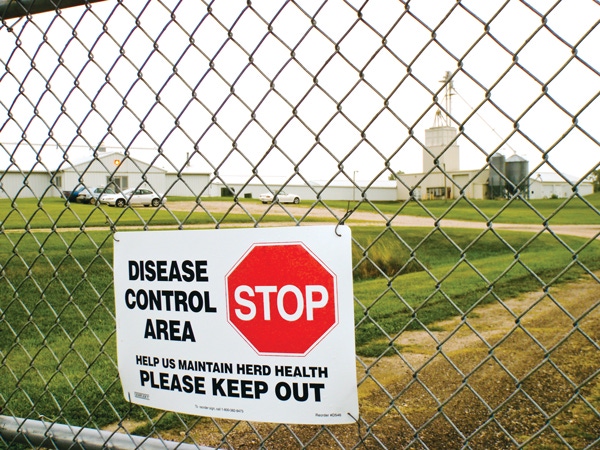
Transportation could indeed be a key weak link when it comes to keeping porcine epidemic diarrhea (PED) virus out of your hog operation. Collection points are especially troublesome in ease of tracking it back to the farm.
However, equally as important to staying disease-free is maintaining internal biosecurity in a production system, says James McKean, DVM, Iowa State University.
“If you have multiple sites, the virus may come into one of those sites. Your goal is to put up enough internal biosecurity to avoid tracking it into one of those other sites and eventually back into your farrowing operation,” he says.
PED virus transmission is oral-fecal, meaning pigs ingest the virus-laden manure and become infected.
Like what you’re reading? Subscribe to the National Hog Farmer Weekly Wrap Up newsletter and get the latest news delivered right to your inbox every week!
To avoid cross-contamination, make sure that all objects, such as boots, equipment and even the bottoms of pressure washers are free of manure and properly disinfected and dried. Wash your hands and wear a clean change of clothes before working in other phases of the operation, McKean instructs.
“If we could get people to think about their internal biosecurity, maybe we could keep the virus in one barn instead of eight barns,” he says. “Then it is easier to get rid of. Take a long, deep breath. Try and get this disease corralled. Then look at what it would take to get it eliminated,” McKean states.
Epidemiological Survey
The American Association of Swine Veterinarians (AASV) is conducting an epidemiological survey to characterize the PED virus outbreak. The USDA Center for Epidemiology and Animal Health has begun work this week analyzing 43 completed surveys (including 18 control herds), says Harry Snelson, director of communications for the AASV.
The database has been scrubbed of any personal identifiers, validated and entered into a database at AASV.
“The objective of the survey is to attempt to identify how the virus was introduced into the U.S. swine herd,” Snelson explains. “While it is unlikely that this survey will identify the specific route of introduction, we are hoping it will provide a hypothesis that we might then be able to research.”
Also, the National Pork Board/National Pork Producers Council working group identified research proposals to fund covering epidemiology, pathogenesis, diagnostics, environment, etc. The research work is set to begin shortly.
You might also like:
Expect Corn Projections to be Dialed Back
Variety Meat: The Hidden Pork Value
Forego Hog Expansion Plans for Now
About the Author(s)
You May Also Like





